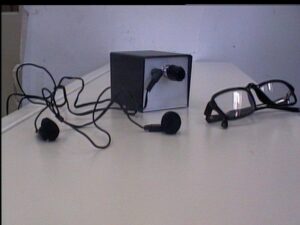Description
 A device for transforming mechanical acceleration into audible sound has been developed. The Acceleration-to-Sound Converter (ASC) produces a variable-frequency sound proportional to the acceleration size. It has various scale and shift capabilities. It comes in two basic configurations. The first consists of separate sensor unit and acceleration-to-sound circuit unit connected by a thin flexible cable. The second combines the two units into one. The sound may be produced by either speakers or earphones. The sensor unit’s size is about 1x1x1 cm and it weighs about 10 gr. The processor unit’s size is about 9x4x4 cm and it weighs about 100 gr. It is expected that these dimensions and weights will be reduced in future designs. The ASC is powered by a 9V source. The figure displays a prototype of the combined unit, containing internally two chargeble 9V batteries, with earphone.
A device for transforming mechanical acceleration into audible sound has been developed. The Acceleration-to-Sound Converter (ASC) produces a variable-frequency sound proportional to the acceleration size. It has various scale and shift capabilities. It comes in two basic configurations. The first consists of separate sensor unit and acceleration-to-sound circuit unit connected by a thin flexible cable. The second combines the two units into one. The sound may be produced by either speakers or earphones. The sensor unit’s size is about 1x1x1 cm and it weighs about 10 gr. The processor unit’s size is about 9x4x4 cm and it weighs about 100 gr. It is expected that these dimensions and weights will be reduced in future designs. The ASC is powered by a 9V source. The figure displays a prototype of the combined unit, containing internally two chargeble 9V batteries, with earphone.
Applications
- Automotive applications: Driving a car on a rough terrain and making sharp turns at high speeds can cause parts to break and even endanger life. The ASC will generate an alarming sound, at a frequency proportional to the acceleration, when the latter exceeds the permissible limits.
- Truck applications: As in automotive applications, plus sounding an alarm when driving a loaded truck at a dangerous slope or tilting the truck-bed too steeply. The ASC responds to a tilt as it responds to deviations from the direction of earth gravity.
- Military (Tank, troop carrier, command car, gun) applications: As in automotive and truck applications, plus sounding an alarm when certain parts, such as a tank gun, are rotated at dangerous speeds.
- Crane applications: Lifting a crane’s arm too fast can cause cable tear and severe damage to load. Tilting the arm beyond a certain angle can cause crane overturn. The ASC will respond by sound to high lift accelerations and to dangerous tilts.
- Aircraft applications: Pulling high “g” forces can cause damages to aircraft, pilots and passengers. Frame vibrations, generated by air turbulence can result in disaster. The ASC will alarm the pilot by a proportional sound when such forces and motions are generated.
- Industrial and surgical applications: Automatic manufacturing often requires high precision. Undesired accelerations of tools and robot arms and imprecise alignments and tilts can cause considerable damage. Similar situations arise in computerized (robotic) surgery. The ASC will sense such accelerations and position drifts and will sound a proportional alarm.
- Medical bio-feedback applications: Certain neurological disorders, such as balance deficiency and Parkinson’s disease, are known to cause both motoric and visual impairments It has been noted that people with such disorders may have distorted visual feedback. Yet, such patients are more dependent on bio-feedback than healthy people. The ASC will create an audio signal corresponding to body acceleration, which will counteract stumbling, falling, tremor and other undesired body motions through bio-feedback. Hyperactive children and adults can learn to control their limb and body movement by training to reduce or eliminate the sound generated by the ASC in response to undesired motion.
Please contact Prof. Baram for details.
